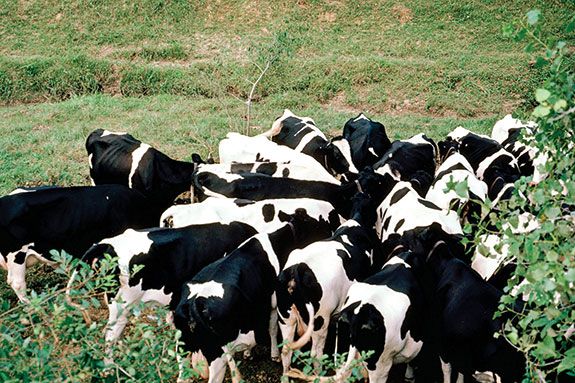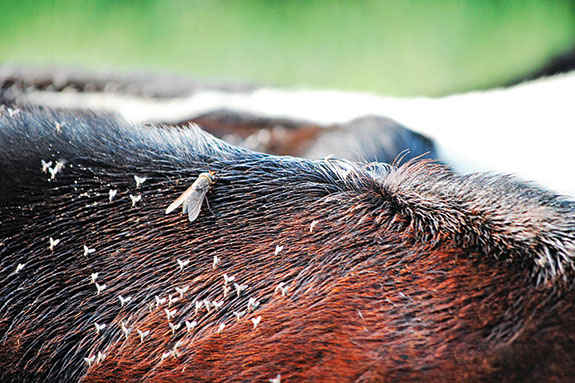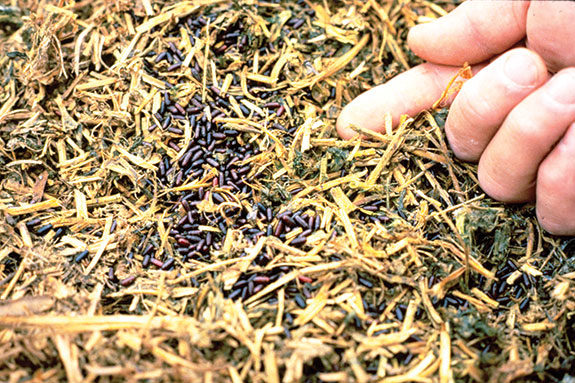Flies are a predictable part of dairying during the warmer months. Flies can injure teats, spread mastitis and pinkeye bacteria, reduce daily milk production and slow growth of replacement heifers.
Organic dairies share many of the same fly problems as conventional confinement operations, but organic herds are exposed to more pests because the pasture rule requires organic herds to spend more time on pasture.
Understanding what these pests are and where they come from can help dairy managers limit animal irritation and economic losses.
Filth flies congregate around confined animals
These summer pests develop as maggots in “filthy,” moist, decaying organic materials such as soiled bedding, wet feed debris and accumulated manure.
Two important filth flies are the house fly and the stable fly. House flies have gray-black checkered abdomens and soft, fleshy mouthparts used to suck up available milk, saliva and manure fluids.
House flies do not bite, but they do spread bacteria among animals and people. House flies can become a nuisance to workers and a public health nuisance to neighbors.
Stable flies have seven black spots on a gray abdomen and bayonette-like mouth parts used to pierce animal skin and take a blood meal.

Stable flies attack cattle, mainly on their legs, and cause animals to stamp, switch tails and bunch.
In the heat of the day, cattle attacked by stable flies will bunch together with tails directed outward in a rosette formation.
Alert herd managers can watch for bunching and use that sign of stress to indicate a need to improve the farm’s fly pest management program.
Stable flies cause substantial economic losses.
Research indicates stable flies can reduce milk production by 90 to 650 pounds per cow per year depending on numbers of flies and length of the fly breeding season. Those losses can be minimized if preventive actions are taken.
Filth fly prevention
Source reduction should be the backbone of stable fly and house fly management. The goal is to minimize the amount of moist, decomposing material available for fly breeding on a premise.
Fly breeding sites can develop where feed is stored and fed, where calves and heifers are housed, where cows loaf when not on pasture and where manure is stored before it can be land-applied.
Waste materials in those types of areas are likely to produce flies whenever temperatures are between 50 and 95°F, and moisture content is between 60 and 90 percent.
Every dairy is different, and conditions can change from week to week, so dairy managers should scout their own premises regularly to locate, clean up and prevent breeding sites from developing.
Under summer conditions, eggs laid by stable flies and house flies can develop into adult flies in less than two weeks, so scouting should be done every two to three weeks to prevent fly populations from getting out of control.
Scouting can be done quickly on foot, paying attention to places where moist organic materials can accumulate. One technique is to use a garden trowel or hoe to scrape into possible fly breeding substrates.
Where present, maggots (fly larvae) will most often be just below the surface. Maggots will move when disturbed, and that motion makes them easier to see.
Barrel-shaped reddish-brown pupae may also be present. Surface layers of feed and bedding may be too dry to be infested, but deeper layers may be moist enough to support maggot activity, so digging to underlying soil or concrete may be required.
Once active breeding sites have been located, infested materials can be destroyed by hauling and spreading, by incorporation into soil, by immersion under water or by being mixed and aerated to encourage active composting.
It is better to destroy infested media than to haul and cold-stack it elsewhere; adult filth flies can travel a half mile in as little as a day.
Winter feeding and bedding management
Winter livestock feeding practices can be modified to help control stable flies in summer. Wastes that accumulate in winter can lead to a stable fly problem in summer if not managed correctly.
Research in Nebraska and Kansas has shown that mixtures of spilled feed and manure around winter hay bale feeders become infested in spring and produce stable flies well into summer.
Unrolling of hay bales or relocation of feeding sites between consecutive bales in winter will keep debris piles from getting deep enough to support stable fly growth later in spring.
Bedding choices for youngstock should be made with filth flies in mind. Calf hutches and youngstock pens can be a major source of stable flies and house flies. Depending on temperature, two to three generations of flies can develop in the time it takes to raise a calf to 6 weeks old.
Research in New York, Maryland and Minnesota has shown that choice of bedding material can greatly affect fly breeding success. Small-grain straw and corn or bean stover may be cheap and readily available, but when mixed with manure and urine, those materials produce many more flies than sand, sawdust, wood shavings and ground corn cobs.
If calves must be housed on bedding, and soiled bedding cannot be replaced every two weeks, then filth fly production can be reduced by using materials other than straw and stover during summer.
Beneficial parasitoids (stingless wasps) can be purchased and released to kill fly pupae in bedding areas, but those wasps are likely to be ineffective if basic breeding site management is inadequate.
Similarly, a variety of fly traps can be used to kill adult flies, but they too can be overwhelmed if source reduction is not implemented.
Flies on pastured cattle
In addition to stable flies, cows and replacement heifers on pastures can also be attacked by two more kinds of filth flies unique to pastures. Those two pasture flies are horn flies and face flies.
Both lay their eggs in fresh cattle dung pats on pasture and not in accumulated manure elsewhere. Two to three weeks later, adults flies emerge from the dung pats and search for cattle in pasture.
Because they breed in cow dung pats, horn flies and face flies are more troublesome on dairies that rely on summer pasture.

Horn flies are ¼-inch long bloodsucking flies that live on the backs and bellies of their host animals.
Much research has shown that control of horn flies leads to 5 percent increases in lactation rate and heifer growth rate during the time of the year when horn flies are active.
More recent research indicates horn flies may play a role in the spread of mastitis.
Face flies are ⅜-inch long and feed mainly on facial secretions.
Face flies are believed to play a role in the spread of pinkeye bacteria, but pinkeye bacteria are spread by other means, too.
A USDA entomologist named W.G. Bruce designed a mechanical fly trap to control horn flies back in the 1930s.
His design is known as a Bruce walk-through fly trap, and it works by collecting horn flies from the animals’ bodies as they walk through the trap.
Plans for home construction are available on the Internet. More recently, a vacuum-powered version was developed at North Carolina State University and is being sold commercially.
Both kinds of traps should work best if positioned where cattle must pass through them twice per day as would occur with milking cows at the parlor entrance or replacement heifers at fenced watering stations.
The Bruce trap has been shown to work well against horn flies, but efficacy against face flies and stable flies has yet to be evaluated.
Pastured cattle can also be attacked by a variety of aquatic biting flies depending on geographic location. These bloodsucking flies are known commonly as horse flies, deer flies, blackflies, mosquitoes and biting midges.
Their larvae develop in natural aquatic habitats including creeks, streams, marshes, swamps and depressions flooded by thunderstorms. Except for a few kinds of mosquitoes that breed in stock tanks, discarded tires and other artificial containers, source reduction is generally not practical for aquatic biting fly control.
A better strategy may be to allow cattle to express natural avoidance behaviors. Besides bunching, cattle will seek refuge in shaded woods or barns, which are darkened areas that light-loving horse flies, deer flies and blackflies tend not to enter.
Cattle will also “hilltop” on windy days and nights to avoid weak-flying mosquitoes and biting midges. There are a number of natural product repellents commercially available.
These products are generally regarded as safe (GRAS) and usually contain blends of essential oils that repel insects and provide temporary relief from biting flies.
Moon is a professor in the Department of Entomology at the University of Minnesota. Watson is a professor and extension specialist with North Carolina Cooperative Extension.
PHOTOS
TOP RIGHT: These summer pests develop as maggots in “filthy,” moist, decaying organic materials such as soiled bedding, wet feed debris and accumulated manure.
MIDDLE RIGHT: In the heat of the day, cattle attacked by stable flies will bunch together with tails directed outward in a rosette formation. Alert herd managers can watch for bunching and use that sign of stress to indicate a need to improve the farm’s fly pest management program.
BOTTOM RIGHT: Wes Watson says this photo illustrates how significantly smaller horn files are than horse flies and they are often observed feeding head down on the backs of cattle. Much research has shown that control of horn flies leads to 5 percent increases in lactation rate and heifer growth rate during the time of the year when horn flies are active. Photos courtesy of Roger Moon.






